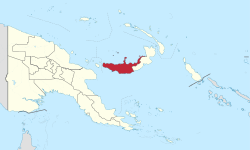West New Britain Province
| West New Britain Province | ||
|---|---|---|
| ||
 West New Britain Province in Papua New Guinea | ||
| Coordinates: 5°50′S 150°0′E / 5.833°S 150.000°E | ||
| Country | Papua New Guinea | |
| Formation | 1976 | |
| Capital | Kimbe | |
| Districts | ||
| Government | ||
| • Governor | Sasindran Muthuvel 2012- | |
| Area | ||
| • Total | 20,387 km2 (7,871 sq mi) | |
| Population (2011 census) | ||
| • Total | 264,264 | |
| • Density | 13/km2 (34/sq mi) | |
| Time zone | AEST (UTC+10) | |
West New Britain is a province of Papua New Guinea on the islands of New Britain. The provincial capital is Kimbe. The area of the province in 20,387 km², and there are 264,264 of the 2011 census count.[1] West New Britain produces palm oil for export. There are seven major tribes, the Nakanai, Bakovi, Kove, Unea, Maleu, Kaulong and Arowe, speaking a total of about 25 languages.
People from West New Britain are widely referred to as "Kombes" throughout Papua New Guinea, in metonymic reference to the significant Kove (or Kombe) people. The Kove people were extensively reported on by the anthropologist Ann Chowning in National Geographic magazine during the 1960s and in consequence a photographic record of their traditional lifestyle has been widely disseminated. Within Papua New Guinea they are most widely noted for their practice of superincision of the penis — circumcision is generally though inaccurately referred to among Papua New Guineans as "the Kombe cut" — a practice formerly also in other regions of northern coastal regions of New Guinea island and the New Guinea Islands but which has elsewhere lapsed.
The predominant religious affiliation is Roman Catholic, though there is a sizeable Anglican presence at the extreme western tip of the province and Bishop James Ayong, the recently retired Anglican Primate of Papua New Guinea, is originally from West New Britain.
There are substantial oil palm plantations on the north coast of the province especially in the Kimbe region, and logging activities in the interior and on the south coast. The Walindi dive resort near Kimbe is a significant tourist destination for overseas visitors to Papua New Guinea.
Districts and LLGs
There are two districts in the province. Each district has one or more Local Level Government (LLG) areas. For census purposes, the LLG areas are subdivided into wards and those into census units.[2]
| District | District Capital | LLG Name |
|---|---|---|
| Kandrian-Gloucester District | Kandrian | Gasmata Rural |
| Gloucester Rural | ||
| Kandrian Coastal Rural | ||
| Kandrian Inland Rural | ||
| Kove-Kaliai Rural | ||
| Talasea District | Kimbe | Bali-Witu Rural |
| Bialla Rural | ||
| Hoskins Rural | ||
| Kimbe Urban | ||
| Mosa Rural | ||
| Talasea Rural |
Members of the National Parliament
The province and each district is represented by a Member of the National Parliament. There is one provincial electorate and each district is an open electorate. The following table lists Members before and after the 2007 general election.
| Electorate | Previous member (party) | 2007 winner (party) |
|---|---|---|
| West New Britain Provincial | Sasindran Muthuvel (Peoples National Congress Party (Papua New Guinea [3] | |
| Kandrian-Gloucester Open | Joeseph Lelang(PNC) | | |
| Talasea Open | Francis Marus (PNC) |
References
- ↑ "PAPUA NEW GUINEA". City Population.de. Thomas Brinkhoff. Retrieved 26 June 2012.
- ↑ "National Statistical Office of Papua New Guinea". National Statistical Office of Papua New Guinea. National Statistical Office of Papua New Guinea. Retrieved 26 June 2012.
- ↑ "NA ahead on 8". Post Courier Online. Retrieved 2007-07-24.
